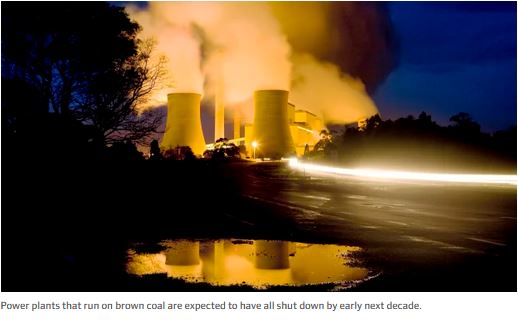
When Shadow Minister for Climate Change and Energy Chris Bowen stated at the Press Council that no jobs would be lost in coal or gas through Labor’s policy he received a strong challenge from Mike Foley of the SMH and The Age (from about 40:00 on the tape) who pointed out that the Government’s modelling showed coal-fired power reducing from 25GW to 14GW, which was more than can be accounted for by stated station closure timelines. Labor is going harder on renewables and claims that 82% of power generation will be renewables by 2030. Surely this means early closure of coal.
Bowen said stations may close, the market will decide, but there was no causal relationship with the policy, and the small percentage is explained by the fact that if we follow the call to ‘electrify everything’, especially heating and transport, much more power will be needed.
Coincidentally AEMO (Australian Energy Market Operator) has just produced it’s 2022 Draft ISP Consultation plan which show coal disappearing, evaporating before our eyes.
Here are some links:
-
Goodbye to coal podcast RenewEconomy podcast
- Angela Macdonald-Smith in the AFR – Early coal power exit demands $12.5b transmission spend
Macdonald-Smith summarises:
-
Australia’s coal power plants are retiring at least five years faster than anticipated, requiring an acceleration of investment in grid transmission, renewable generation and storage to replace it, including $12.5 billion of urgent transmission projects.
Almost two-thirds of coal generation capacity is likely to be gone by 2030, the Australian Energy Market Operator said in its draft blueprint for the power grid for the next 30 years, which has been overhauled with the race to net zero emissions, which the electricity sector is now expected to reach well before 2050.
Power plants that run on brown coal are expected to have all shut down by early next decade.
Almost all coal power plants will be shut by 2040, with the last perhaps clinging on until 2043, AEMO said, anticipating closures will come much earlier than the official dates given by their owners such as AGL Energy and Alinta Energy.
That means a nine-fold increase in utility-scale renewable energy generation is needed to help replace coal power and meet higher demand for power as the economy electrifies, AEMO said in its draft 2022 Integrated Systems Plan, which was drawn up after extensive consultation with industry, policymakers, governments and other stakeholders.
In addition, more than 10,000 kilometres of new transmission lines are needed to connect wind, solar and other new generation plant to consumers. Local networks must be reconfigured to allow two-way flow of power as rooftop solar booms.
AEMO’s base case outlook is now the “Step Change” scenario rather than the “Central” scenario used in its 2020 blueprint, which has been left behind by the rapid expansion of large-scale renewables and rooftop solar, and the accelerating shift away from coal power.
It is important to note that AEMO is not pushing a barrow, it is simply reflecting what industry stakeholders think will happen and we should be planning for.
Here are some graphs to grasp the scale of what is happening.
First, what the Step Change scenario looks like against the official closure times of coal plants.
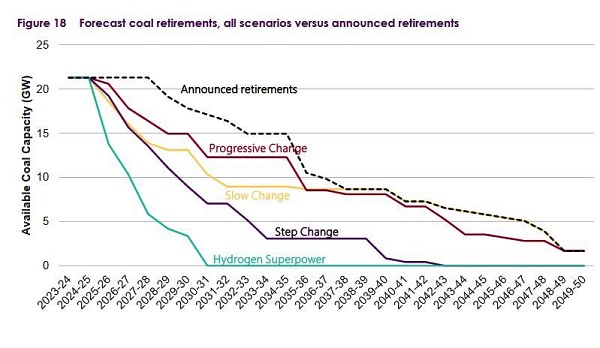
Here is the pattern of coal closure by state:
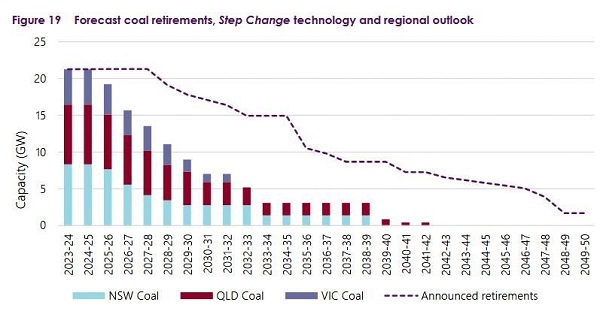
This one shows the stunning increase in renewable energy:
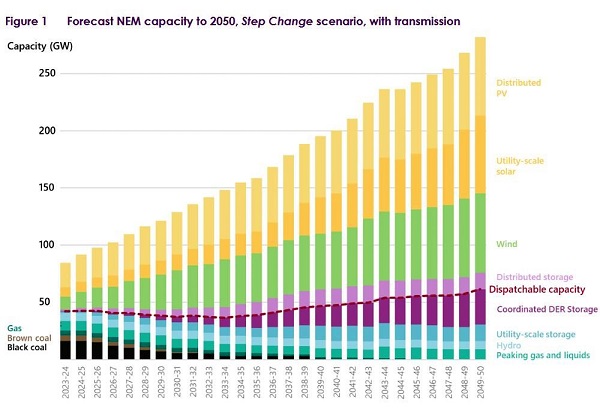
Macdonald-Smith points out that the ISP:
- anticipates the construction of nine times the NEM’s existing large-scale wind and solar generation, from 15 gigawatts to 140 GW.
On a per capita basis, that means maintaining Australia’s world-beating rate of renewables growth of 2018-19 every year for the next decade to triple capacity by 2030, then almost doubling it again by 2040 and again by 2050.
Coal is a smudge at the bottom which disappears.
Gas, which is currently supplying about 4% of NEM power, maintains its output, but is dwarfed by the growth of renewables.
This graph shows that much of the storage capacity will be decentralised:
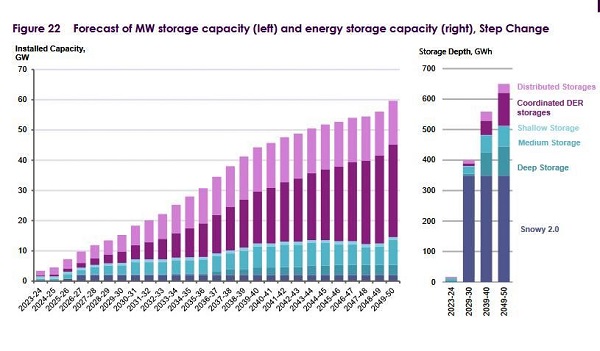
None of the above can happen unless a modern grid built to cope with decentralised power generation and consumption is built at an early stage. The ISP calls for more than 10,000 kilometres of new transmission lines. This work is “Urgent and extensive”. AEMO has now released NEM Engineering Framework: Initial Roadmap, December 2021 laying out the technical requirements and strategic design decisions needed.
I suggest the truth is that we do not need to fret about closing down coal. Coal is leaving in a manner that may be disorderly. Our struggle is to optimise the outcome and keep the lights on along the way.
This is a three day intersection showing the daily NEM pattern which has been evident for some time:
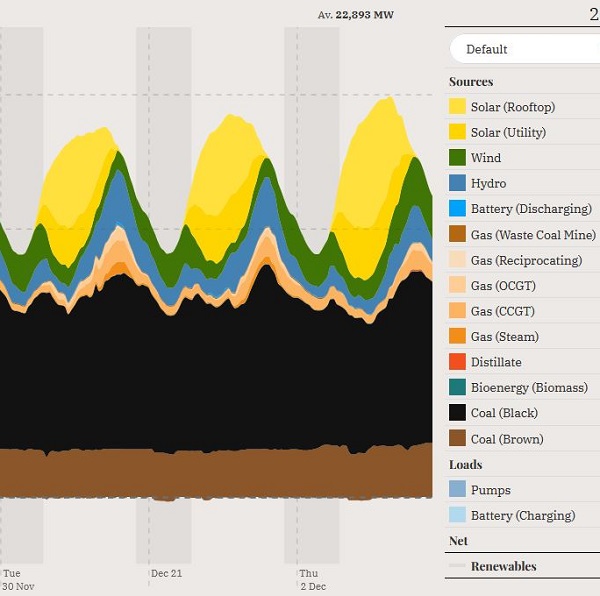
Black coal is being ramped twice a day as solar floods in. Batteries discharging only account for 0.07% of the market at present with gas fired power at 4.2%.
Coal power is not meant to be ramped and it is not good for the plant. The biggest damage, however, is to the price. The following image is a representative day of the spot price in Queensland from a talk by Dr Maia Schwarzer, CEO of CleanCo, I think in July this year:
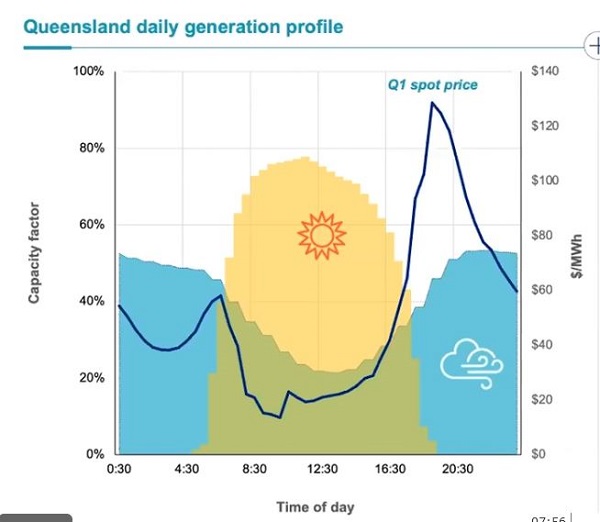
In the September quarter record levels of renewable energy drove down electricity prices across Australia:
- Prices were zero or negative for 16% of all trading intervals during the quarter, more than double the previous share set during the final three months of 2020 at 7%. (Emphasis added)
Stanwell explains that it costs more to stop and start a coal-fired power station than to suffer negative pricing. I did hear of one instance where a coal power station bought renewable power to fulfill its contract rather than crank up their own boilers.
The AFR reports that prices were at an eight-year low, according to the latest ACCC report. The Government claims credit where it is not due.
Returning to the AEMO ISP they see renewable power share as progressing in this fashion:
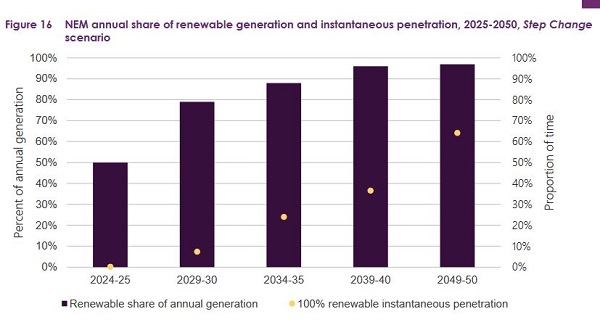
In remarkable synchronicity Labor’s Powering Australia sees 82% renewables by 2030.
The Climate Council has renewed its call for 75% reduction in emissions by 2030 with “so much at stake”. At the same time it has, with other organisations, issued a statement saying that renewable energy transmission lines are essential to reducing pollution, protecting climate and preserving nature. The scale of what is needed is shown in this image from the AEMO ISP:
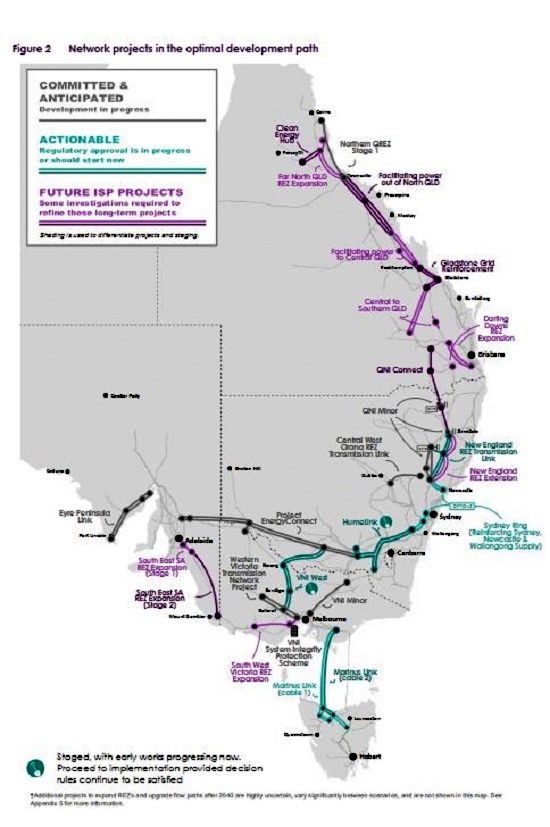
When asked by Laura Tingle at the Press Council what the main drivers were in Labor’s emissions reduction plans Chris Bowen deferred to the Reputex modelling which mathematically gives it to the SafeGuard Mechanism, then “https://alp.org.au/policies/rewiring_the_nation”>Rewiring the Nation.
The truth is that both are essential, and then some. However, pushing coal out the door is not the immediate problem. It is leaving and we have to deal with the consequences.
It is a fair bet, I think, that Bowen was not surprised by the AEMO draft ISP. As to what goes on in Angus Taylor’s mind, no-one knows. I think not even himself. That constitutes a problem while he has access to the levers of power.

Brian: Not sure what is going to happen with metallurgical coal. (If met coal needs remain unchanged some thermal coal will be produced as a byproduct and may to continue being used for power production.) However:
1. Green hydrogen may fully or partially replace metallurgical coal for steel production.
2. Technologies are available for using thermal coal to produce steel thus reducing the need for metallurgical coal
John, in this post I was only looking at coal in the electricity system, but your comments are interesting.
Gas is another matter.
If we really want to be depressed, try Alan Kohler: Politicians are failing us on climate change. They must do this instead.
As a pedant I can find fault in many places, but basically the story he tells is right, except the situation is worse than he appears to understand.
The truth is that there is no budget of burnable carbon for a safe climate. The Greens and Climate Council target may be impossible, but there is a fair chance it would be too late.
It rather depends on tipping points and we may have smashed one:
Scientists warn Antarctica’s ‘Doomsday Glacier’ could SHATTER within the next five years
‘Doomsday Glacier’ could meet its doom within 3 years
When the glacier shatters it will be too late to stop it. The heat is in the ocean.
Science and politics would then change complexion, one would think.
Brian: “If Thwaites were to break up entirely and release all its water into the ocean, sea levels worldwide would rise by more than 2 feet (65 centimeters), said ITGC lead coordinator Ted Scambos, one of the presenters at AGU and a senior research scientist at the Cooperative Institute for Research in Environmental Sciences (CIRES).
“And it could lead to even more sea-level rise, up to 10 feet [3 m], if it draws the surrounding glaciers with it,” Scambos said in a statement, referring to the weakening effect one ice shelf collapse can have on other nearby glaciers.”
Bugger. 65 cm may be enough to cover the road that leads to our place!! Time to plan a move?
War footing anyone?
What found in my career is that you often get better answers if you set big challenges instead of small ones. For example: “improve by 5% in the next 5 yrs” is likely to produce suggestions for minor changes.
“Improve by 50% over the next 12 months” is more likley to produce radical proposals. (OK some suggestions may be less than 50% or take a bit longer but the big challenge gets people thinking big.)
What Glasgow produced was the minor challenge. A minor challenge that will allow the Morrisons of the world procrastinate and leave any action to their successors.
Perhaps we need some real challenges. For example: “What would we do if we we had to stop producing and importing thermal coal by Dec 2022?”
Perhaps better still: “What would we have to do if we had to stop extracting and importing fossil carbon by Dec 2022?”
We may be surprised by what could be done if we were given no choice or we might find that things to is desirable to do first need a bit more time that one year.
I promise to write a post with a hit list of doable things and desirable research.
John, there was an article from Nine news that emphasised Queensland cities, for reasons that are not clear to me, because it referred to Coastal Risk Maps for Australia. If you click around you will find Ballina, and it is not pretty.
These are official IPCC maps, based on a low-ball forecast of a possible 84 cm rise by 2100.
What the new research is saying is that the IPCC numbers are out of date.
The real problem is the difference between geologic time and human time and risk. What is happening is that we have a geologic event which is similar to the asteroid strike 65 million years ago. ‘Instant’ in geologic time can be anywhere between days/months/years and millennia.
There was a very sharp SLR incident towards the end of the Eocene, which saw 3 metres in a very short human time. My old brain can’t remember whether it was months, years or decades.
I know where the information was, and will try to look it up, but my life does not have a lot of space in it at present.
John, I look forward to your post.
I agree that we are overdue to put climate on a war footing.
I’ve had a couple of days out of action. Along the way got a COVID third jab and had my computer upgraded.
I tried to post a link to RenewEconomy link here, and the damn thing came up with ‘Internal server error’ which it is still doing, only now faster.
The Parkinson article – All signs point to a quick transition to renewables. But can we connect them? says that the biggest bugbears for any developer are grid connection and no Commonwealth policy.
Clean Energy Council CEO Kane Thornton says grid connection has emerged as the single greatest challenge for renewable energy projects since at least 2019, and the issue is acting as a stop to the enormous capital flows that should be flowing into the Australian economy through clean energy projects.
Here’s the link.
Merry Christmas Brian and John, thank you for your continuous efforts and valuable insights throughout the year. Wish you a healthy and happy new year.
Cheers Ootz
Thankyou Ootz. Merry Christmas to you and all.
Our Christmas has been a bit merrier than we bargained for with a household member coming back here from ‘virus central’, that is from Sydney.
The matter is being investigated and you will know the truth as soon as we do, or shortly thereafter.
Ootz: Thanks Ootz. Look forward to your comments for the new year.
David Spratt at Climate Code Red is posting a series in rapid succession on tipping points.
From Part 2:
Richard Alley, a world-leading Penn State University glaciologist, says that the most likely place to generate the worst-case scenario is Thwaites, warning that “even six feet of sea level rise by 2100 is not the worst-case scenario… We just don’t know what the upper boundary is for how fast this can happen. We are dealing with an event that no human has ever witnessed before. We have no analog for this.”
Part 4 ends with a quote from James Hansen:
On the scientific front, several colleagues and I assert that IPCC has underestimated the sensitivity of climate to growing freshwater injection from melting ice. One potential consequence – if we continue with business-as-usual emissions – is shutdown of the overturning North Atlantic and Southern Ocean overturning ocean circulations by mid-century, each of which will contribute to acceleration of mass loss from the Antarctic ice sheet, with the likelihood of sea level rise of several meters within the lifetime of children born today. (Emphasis added)
Yes, Brian, we have known and talked about probabilities for years. Now those probabilities are becoming certainties. Where are the denialists, what were their names again?
Remember how the IPCC took a conservative path to not “Alarm” people largely on the protests of denialists?
What is happening with twiggy Forest’s low CO2 steel? And the power cable to Singapore?
Related issue” Directair capture machines suck carbon dioxide from the atmosphere. Are they part of the solution to climate change?”
The article quoted this figure for using forestry to lock up carbon:
The big attraction of forrests is that they capture carbon and release oxygen instead of storing the oxygen far underground.
John, the link does not work, and I can’t see why. I’ve googled and I’ll try it again – Direct air capture machines suck carbon dioxide from the atmosphere. Are they part of the solution to climate change?
Found the problem, John. When you copied the link the https:// was left off.
Trees may be part of the solution, but I don’t like them as formal offsets. They take too long to grow, they burn and they also darken the landscape so it absorbs more heat.
The linked article is worth reading to the end, including:
But underground storage isn’t the only option, Professor Howden said.
“Probably the dumbest thing we can do with captured CO2 is put it in the ground,” he said.
“To my mind, if we’ve gone to the bother of capturing CO2, why not treat it as a resource?”
bilb, back in 2010 I penned a post Dangerous global warming is here after an attack of pessimism from you.
The IPCC and the UNFCCC were set up in the early 1990s to avoid dangerous anthropogenic interference DAI) in the climate.
It has been blatantly obvious for over a decade that they have failed, yet they are operating now much as they did then. That is, with a lack of realism, certainly warnings, but also false hope.
Countries, companies, states think they can make money out of fossil fuels during a ‘transition’ period, and they are doing that to the max. Emissions increase in an upward curving trend, with no blip, so far, from COVID.
That is a good article John D. It’s a little ironic to build a facility in Iceland where there are volcanoes spewing CO2 into the atmosphere to then use the geothermal heat energy to suck that CO2 back and poke it underground again. It’s the thought that counts. This is of course a pilot exercise and using non CO2 emitting energy is what it must be.
The optimal solution would be a floating kilometer high tower on the equator using the rising airflow to generate the power to operate the CO2 capture process and the process to pump (possibly no pumping required) the captured CO2 to a depth of 4000 meters where its density (1.1 times that of water) will keep it sequestered hopefully indefinitely.
The 4000 meter down pipe would keep the structure upright, but the wind age on the 1000 meter high flue would be enormous and keeping it in place over the sequestering channel would be the issue.
Bilb: Bit skeptical about the rising airflow at the equator being fast enough to to generate power or that compressed CO2 pumped to the bottom of the ocean will stay there over a long enough time. (Let alone all the extinctions that may be caused by dumping it there.)
May be worth looking at at ways of storing carbon that produce something useful.
I’m a bit of a hoarder by nature, and in principle would like to store stuff like carbon and oxygen, which are inherently useful, in ways that are retrievable in the future.
Of course, John, these are not my ideas, they have been explored in the past. Australia’s exploration of the Solar Tower idea back in 2006.
https://www.iatp.org/news/australia-considers-one-km-tall-power-tower
And Ocean storage of CO2
https://www.maritime-executive.com/features/ocean-storage-of-co2
The difference here is that they are talking about sequestering CO2 from Coal Power Stations, where as I am suggesting direct Carbon Capture from the atmosphere with an integrated power system.
……. and ……
https://www.dailymail.co.uk/sciencetech/article-4899020/Carbon-dioxide-stored-liquid-LAKES-sea.html
John, in the past you have enthused on the production of Methanol Fuel from CO2 and Water, and even though to use Methane as a combustion fuel is an inefficient process, if it allows surplus wind power to be stored I think it is a very rational process.
At the very least it can be used to power Elon’s rockets, but methanol has been used of farms for powering farm machinery for decades.
Brian: You can store/use carbon as timber, coral, charcoal based soil improvement, straw houses and……………?
What Brian was saying, John, is that carbon is an essential building material which the future needs to have in abundance. It took hundreds of millions of years for nature to extract the Carbon from the atmosphere in a once off event before the evolution of lignin eating microbes, and condense it to a readily accessible concentrated form. We are blowing that off to unnecessarily use the energy in a highly inefficient way.
If the CO2 is concentrated where it can be accessed as liquid CO2 or clathrates in the Oceans, it can be used in the future for building the things civilization needs (of course the energy extracted from its combustion is needed to obtain the Carbon again).
We are using Carbon as as irresponsibly as Nauru gave up its phosphate for momentary prosperity, and future humanity will suffer.
The best use for Coal Carbon is in the form of Carbon Fibre ie permanently sequestered in structural form and in a recyclable way.
Timber and straw houses the carbon will wind up in the atmosphere and eventually be absorbed into the ocean an rocks being lost to humanity permanently. Charcoal is permanent sequestering if it is in the soil, but again dispersed. Is there carbon in coral.
Brian: Labor to unveil support for taxpayer-funded construction of gas-fired power station in the Hunter Valley. The proposal is that it will operate on green hydrogen in the future to make the proposal more acceptable to people who are concerned about climate change.
Does seem a bit strange (bloody stupid) to be proposing that clean energy will be generated in the Pilbara to produce green hydrogen that will then be shipped all the way to the Hunter valley to be evaporated to make fuel for a gas fired generator.
A nasty sceptic might might wonder why they don’t just produce the clean electricity in the Hunter Valley.
Bilb: “Is there carbon in coral.” Coral is calcium carbonate. Much of the worlds limestone is calcium carbonate that comes from the fossilization of reefs.
I remember solar towers based on the principles you mentioned but I guess they did not compete with developments in wind and solar panels.
You are right that I have advocated green methanol in the past. It can be transported at atmospheric pressure and is more energy intensive that green ammonia.
Green ammonia has the attraction of not requiring the extraction of CO2 from the air for it production and has the same transport pressure as LPG.
Liquid H2, like LNG can be transported at atmospheric pressure and makes sense as a medium for transporting clean energy over long distances. About 25% of the energy in natural gas is used to convert it to LNG. Not sure what the figure is for hydrogen.
Brian: Renew economy on Labor’s amazing proposal for a green hydrogen gas fired generator to buy votes in Kurri Kurri.
Not surprising that RenewEconomy was hardly flattering about Bowen’s latest effort to undermine Labor’s credibility:
Bowen’s efforts on tax breaks to the oldies helped lose the last election. This blooper isn’t going to help this time around.
John, I’d tend to run with Bruce Robertson on this one for two reasons.
Firstly gas is worse than we thought (probably twice as bad or more) and given the state of the climate crisis (or looming catastrophe) burning anymore fossil fuel is bad.
Secondly, the project is unnecessary, so the government intervening to do it indicates to capitalists that the government is irrational, and it might be better to invest somewhere else in the world.
So to make it a hydrogen trial project is like making a silk purse from a sow’s ear, or putting lipstick on a pig.
I’m not smart enough to know whether it’s good or bad politics. I kinda think it won’t impress the locals, and won’t help Labor’s green mission elsewhere.
Bilb, storing CO2 in lakes in deep ocean trenches does seem worth consideration. The article does acknowledge that creatures live there, and we know less about what’s down there than we know about the surface of Mars, or so I’m told.
My impression is that the area required is not large, and the benefits for the rest of the planet may be crucial.
Statements like this make me cross:
The trenches could help keep Earth’s temperature at a safe level – now agreed to be no more than 1.5°C (2.7°F) above average pre-industrial time temperatures.
There is nothing safe about 1.5°C. We have dangerous climate change now, and 1.5°C has to be more dangerous.
Greenland melting has increased 7 times in 3 decades. Antarctic melting has trebled in 5 years.
There is so much heat in the ocean that we may have to reduce CO2 concentrations to less than 280 ppm to mitigate ice sheet decay. To do that may require a war effort approach and all means at our disposal.
/rant
Brian I’m going through the 2010 thread you referenced above. It’s a good read, and there were so many more people willing to be a part of the discussion, despite my gloom.
12 years ago that was, and what has improved in that time?
Oh I know, Scott Morrison happened!!
I was interested to see that Wagners is planning to use clean concrete that uses byproduct fly ash and ironmaking slag to make cleaner concrete.
Iron making slag will still be produced as a byproduct of iron making no matter what process is used. Fly ash production will disappear once coal fired power disappears. However, there is a lot of fly ash stored around the world.
Thanks, John. Sounds worth doing:
We want to have a positive impact on the environment and supply our customers with an excellent product, that is why we created Earth Friendly Concrete ® by Wagners. It is a concrete that uses no ordinary Portland cement, instead using a geopolymer binder system made from the chemical activation of two industrial waste by-products – blast furnace slag (waste from iron production) and fly ash (waste from coal fired power generation). Our product has ZERO Portland cement and it has a much lower embodied energy compared to ordinary concrete, saving 250kg of CO2 for every cubic metre poured. Importantly, the engineering and construction properties of this environmentally friendly concrete is, in some areas, better than normal concrete. EFC has some significant performance advantages over normal Portland cement concrete, including improved durability, lower shrinkage, earlier strength gain, higher flexural tensile strength and increased fire resistance. (Emphasis added)
Meanwhile, back in darkest South Australia: “South Australia about to set fire to underground coal, and its green energy credentials.” This not long before a state election. ”
The conversation was, hardly surprisingly, scathing about Labor’s green hydrogen fueled gas turbine.
Graham Readfearn is very fair in Does Labor’s green hydrogen plan for the Kurri Kurri gas power plant stack up?
Answer – “no”!
Definitely NO!
From a Labor supporter point of view it is not much more stupid that the government’s proposal.
John, I think I saw a short report on this in the AFR.
Unbelievable!!
John, on Kurri Kurri, possibly worse. The COALition have been erratic and arbitrary. Labor did not have to join them even as (if true) Finance Pivots to Green Hydrogen:
Green hydrogen production is accelerating, and according to IEEFA is approaching light speed.
“Australia is clearly showing the world’s electricity market the future. On sunny days — 10am to 3.30pm daily — electricity prices are now negative. EVs, batteries and pumped hydro can absorb some of this negative cost electricity, but low–capacity factor GH2 facilities will profiteer on spilled electricity as electrification of everything drives decarbonisation.”
The elements that make up the manufacturing supply chain are scaling up. …
This is a slight problem for us here in Quinceland and for the human race:
New research shows global warming of 1.5C will be catastrophic for almost all coral reefs worldwide, even sites scientists once thought of as refuges – none of which are known in Australia.